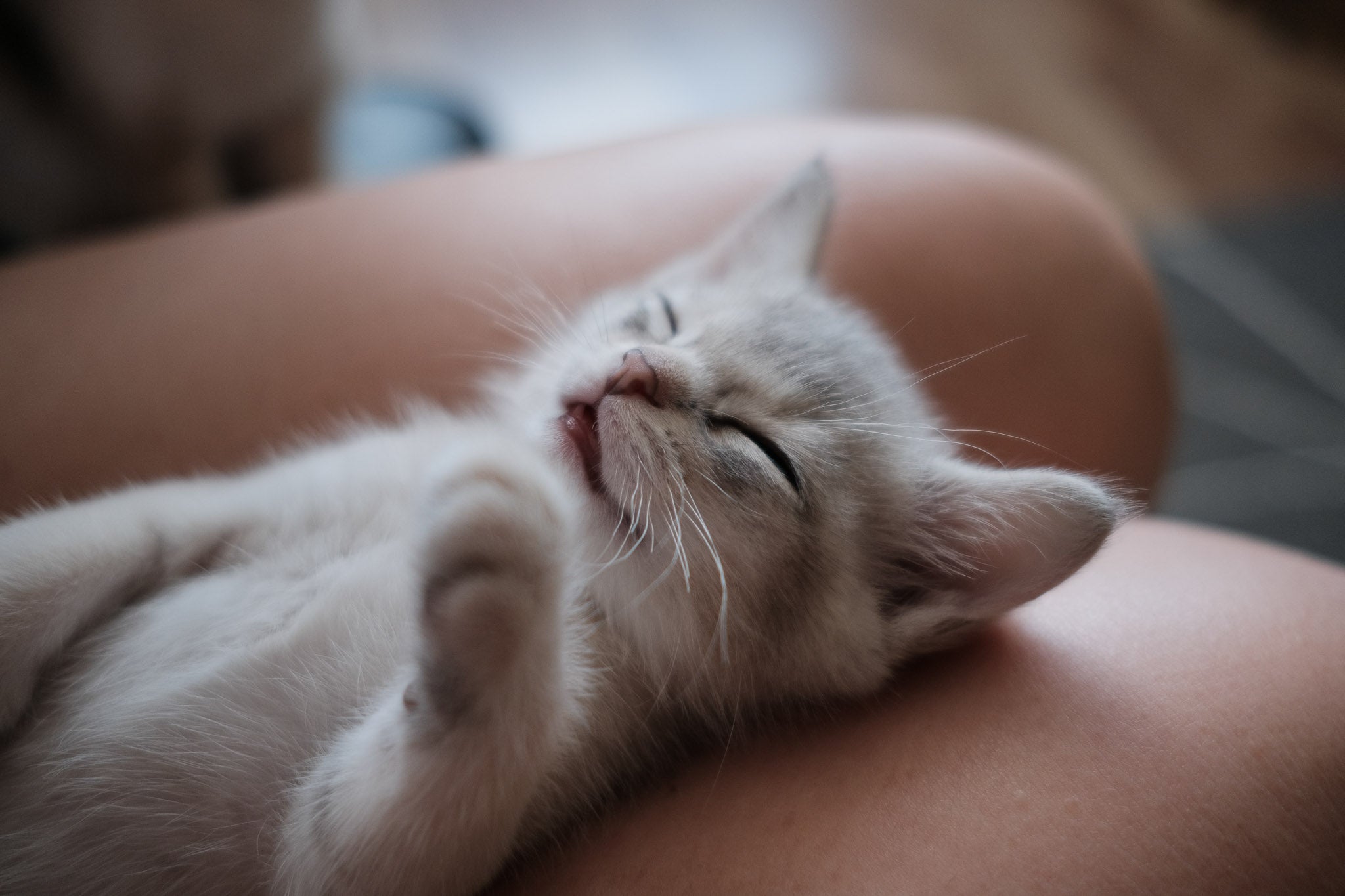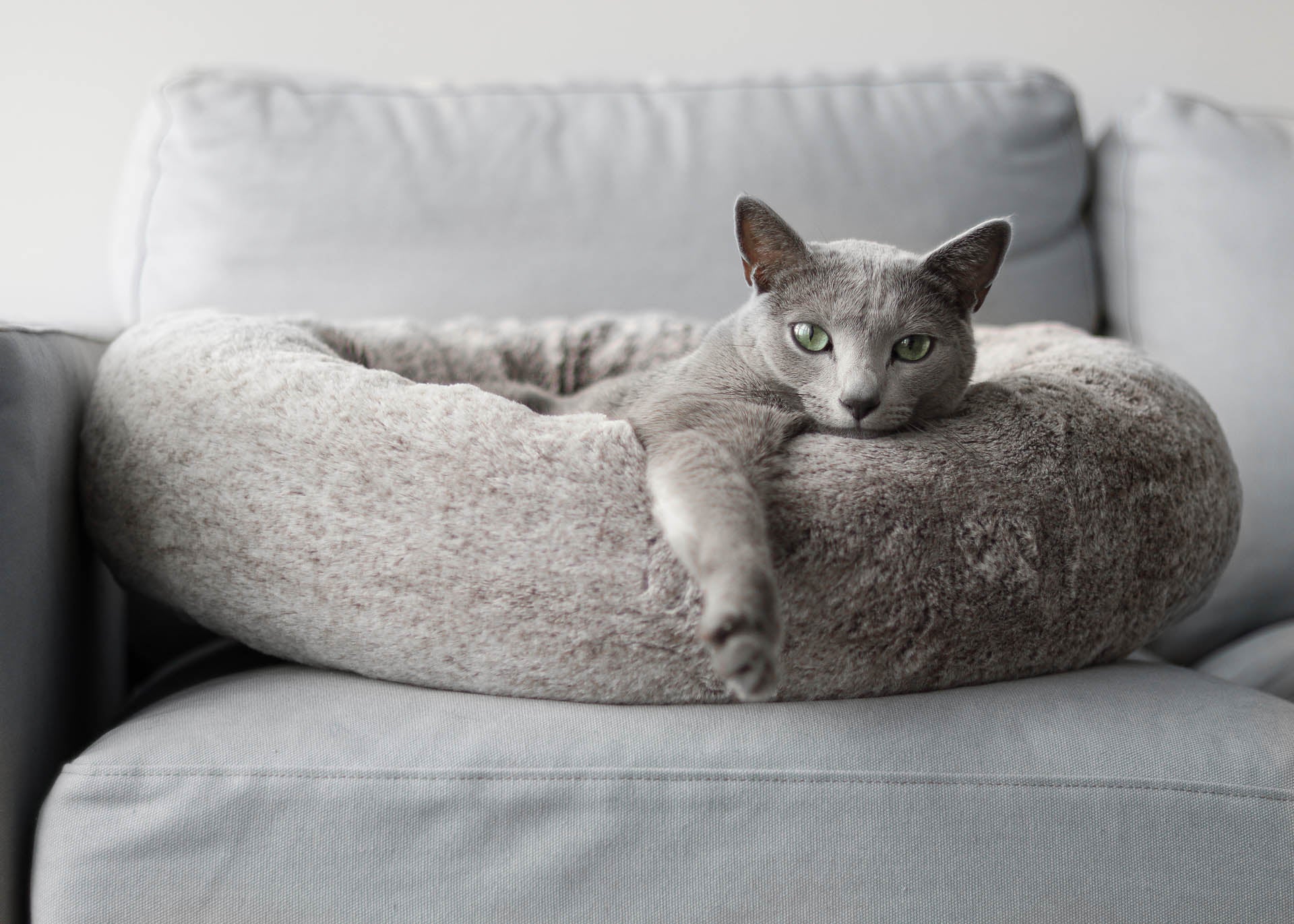
Cats never cease to amaze us with their odd but sometimes affectionate behaviors. Their sleeping habits are no exception, from intriguing sleeping habits to questionable sleeping positions. Have you ever asked yourself, why does my cat sleep between my legs?
In this article we'll discuss the following topics:
- Common reasons your cat sleeps between your legs;
- Should you let your cat sleep with you;
- Alternative sleeping places for cats;
- Why kittens shouldn't sleep with their owners;
- When to worry about your cat's behavior.
Why Does My Cat Sleep Between My Legs?
Warmth
According to PetMD, the normal body temperature for cats is between 37.5 and 39 degrees Celsius (between 99.5 to 102.5 degrees Fahrenheit, approximately). Your cats core body temperature is quite a bit higher than your own, and maintaining it makes for a more comfortable cat. Though cat's are able to regulate their own body temperature through intelligence and bodily processes, snuggling between your legs is one great way for them to keep warm, especially since their body temperatures drop when sleeping.
Deeper Sleep
Domestic cats don't need to worry about being prey for larger animals, yet it is in their instinctual nature to sleep lightly in the event of needing to defend themselves.
So when they want to rest more deeply, they seek extra protection so they can be vulnerable without the feeling of being in danger. Cats like to relax their bodies, get extra cozy and block out light and noise with their paws on their heads.
To feel secure and enter deep sleep, kittens may sleep close to their mother, while adult cats curl up with other cats, if not close to their owner.
Being able to have a deeper sleep is crucial for cats. This stage allows their bodies to heal, grow and develop, regaining energy and making them feel energized and alert when awake.
Another essential sleep cycle is REM, commonly seen when cats twitch while sleeping. In this stage, cats dream, which stimulates their memory and learning abilities.
Security and Bonding
If you are taking good care of your cat, you are strengthening your bond with them. As a result, your cat will likely feel safe around you. Choosing to sleep between your legs is an easy choice for cats to make when they are comfortable with you and feel safe.
This behavior may also be interpreted as a sign of affection, where your cat sees you as part of his family. John Bradshaw, the writer of "The Behavior of a Domestic Cat", noted that when cats sleep upon a person, they're showing affection, also mimicking natural feline instincts.
In the wild, cats will curl together to sleep, strengthening their bond as a family. Domestic cats can display this behavior, called pillowing, with other cats from the same household or as an alternative to humans.
Providing Comfort
Besides the need to feel protected and rested, cats are also said to be sensitive to their humans' emotions and well-being.
So if you notice that your cat tends to lay down between your legs and purr when you're not feeling well, it may be that your cat is trying to comfort you and make you feel better. A simple display of care and affection.
Territory
Apart from the mentioned reasons for sleeping between your legs, your cat can also be claiming ownership of you and your bed. As cats are territorial animals, they leave their scent around the house in an effort to mark their territory.
If you have more than one cat, you may even notice that sometimes they compete for particular sleeping areas, including your legs.
Vantage Point
Besides being warm and secure, a resting spot between your legs also represents a strategic observation point for your cat.
Domestic cats differ from wild cats, but they tend to display the same instincts as they would in the wild. As such, felines prefer to sleep in elevated areas for awareness and the ability to keep an eye on prey and predators. It allows them to survey their surroundings entirely.
Likewise, when sleeping between or on top of your legs, they can keep an eye on the whole room. It's a position where they can see everything, jump in any direction, and have an escape route if needed.
Stress and Anxiety
Although your cat staying close to you can very well be considered normal behavior, it's important to know that there could be concerning reasons for this as well. Separation anxiety in cats can be linked to stress or health issues.
An anxious kitty can become more dependent and territorial, sleeping as close to you as possible. This could be between your legs, on top of you, or anywhere else close by.
When possible, identify the stress factor and control it. Your cat might feel discomfort and anxiety, even due to smaller factors like new cat food or a different type of litter. Cats like routines, so even small changes can disturb them.
Should I Let My Cat Sleep with Me?

There are advantages and disadvantages to letting your cat sleep with you in bed. Before deciding if you allow or disapprove of this behavior, you should consider both the benefits and downsides.
One benefit of sleeping with your cat is allowing for bonding which can support stress relief for both of you.
On the other hand, if you are a light sleeper, it might not be the right option for you. Besides the weight and positioning of your cat, cats tend to be more playful during nighttime, which can be disruptive to your sleep.
On top of that, if you suffer from allergies or health issues, having a cat on your bed can worsen symptoms or sensitivities.
Finally, if you have an outdoor cat, you probably don't want them sleeping with you. You don't know where they have been and if they may have picked up something that could be harmful to you.
So, where should my cat sleep if I don't want him to sleep in bed with me?
Read on...
Alternative Sleeping Places for Cats
Loving your cat doesn't mean that you have to let him sleep on you even if he keeps insisting on it. All it takes is a little encouragement, some patience, and a few appealing alternatives.
Setting up alternative sleeping arrangements doesn't need to be a nightmare. It will take some trial and error as cats have different preferences, but with all the alternatives available, you will find what works best eventually.
The main thing to remember is that good quality, comfortable materials, and pet-safe options are must-have features when choosing beds for your cat.
Heated Pad
If you suspect that your cat is using your legs as a personal heater, then you could consider getting your cat a heated pad. Cats often develop a strong liking for heated pads, as they do most warm places in the house. It can quite easily become your cats' favorite sleeping or lounge spot - A great alternative to using you as a bed.
Heated pads can be placed inside or on top of cat beds to promote their use or simply for added comfort.
Cat Beds
Cat beds are a must for providing dedicated sleeping areas for your cat, but finding the perfect one can be challenging. There are so many options that it's understandable if you are unsure where to start looking, however chances are that your cat is already giving you some clues.
Regardless of the bed type, keep in mind that their preferences can change as they get older, so it's best to provide them multiple sleeping options to meet their changing needs.
Also, once you have discovered your cat's preference, keep in mind your space and needs as well. Cat beds should be easy to clean and offer an aesthetic that doesn't clash with your decor. There are beautiful and comfortable alternatives to make you and your pet happy.
Nest-Like Cat Beds

If your cat appreciates nestling into a warm and soft space (think laundry basket or pile of clothes), you should consider a nest-like cat bed that offers warmth and comfort.
With rounded, raised walls and generous cushion, nest-like beds can help provide a sense of safety and security that helps ease anxiety and stress in cats. Some of these beds are made with faux fur, which can be comforting as it offers the familiarity of cat fur.
Placing an item of your own clothing within it is a helpful way to get your cat to start using the bed.
Cat Caves

On the other hand, if your cat seeks small crawl spaces or hideouts to sleep, a cat cave might be the right choice. Cocoon-like in shape, these beds are adored by cats since they provide an enclosed space that is not only warm but provides some privacy.
Cat Wall Shelves

Wall shelves are a great alternative if you don't have a lot of space for cat beds and still want your cat to have a space of their own to sleep.
Utilizing vertical space, you can install cat wall shelves and create a luxurious sleeping spot by including a heated pad or comfy bedding. Some wall-mounted cat beds also exist.
This particular alternative can be multi-functional, doubling as a climbing spot or perch, keeping your cat healthy and happy.
Where Should Kittens Sleep at Night?
When introducing a kitten to a new home it's often suggested to let them sleep alone, in a single room that contains everything they need (litter box, food, water and a bed).
Kittens often take a while, sometimes a few days to get comfortable in a new space, let alone with people. In the first few days, a kitten can be uncomfortable sleeping with unfamiliar people/pets and may have a litter accident if they are kept far from their litterbox. Don't be surprised if a cardboard box is their preferred sleeping spot for the first few nights, but it doesn't hurt to leave a pet bed nearby.
Like adult cats, kittens prefer higher, warmer, and cozy places to curl. An enclosed or high-walled cat bed are great choices.

When to Worry About a Cat Sleeping Between Your Legs
Nine times out of ten, you don't have to worry about your cat sleeping between your legs. It's likely associated with one or more of the very normal and common reasons we've mentioned above.
But, if it is a new behavior noticed in combination with other behavioral changes, your cat might be experiencing pain or discomfort in some way. Pay attention to changes in appetite, stool, and general behavior. Sometimes the slightest changes in routine or the household can stress a cat.
Routine vet visits are important and will help rule out any health concerns.
Final Thoughts
If your cat likes to sleep between your legs, it's most likely a sign of affection and means your cat feels safe and comfortable with you - Normal and affectionate cat behavior.
Nevertheless, if you don't want to sleep with your cat, there are plenty of alternatives that will provide you both with happy sleeps.

Comments (0)
Back to Noots Cat Blog